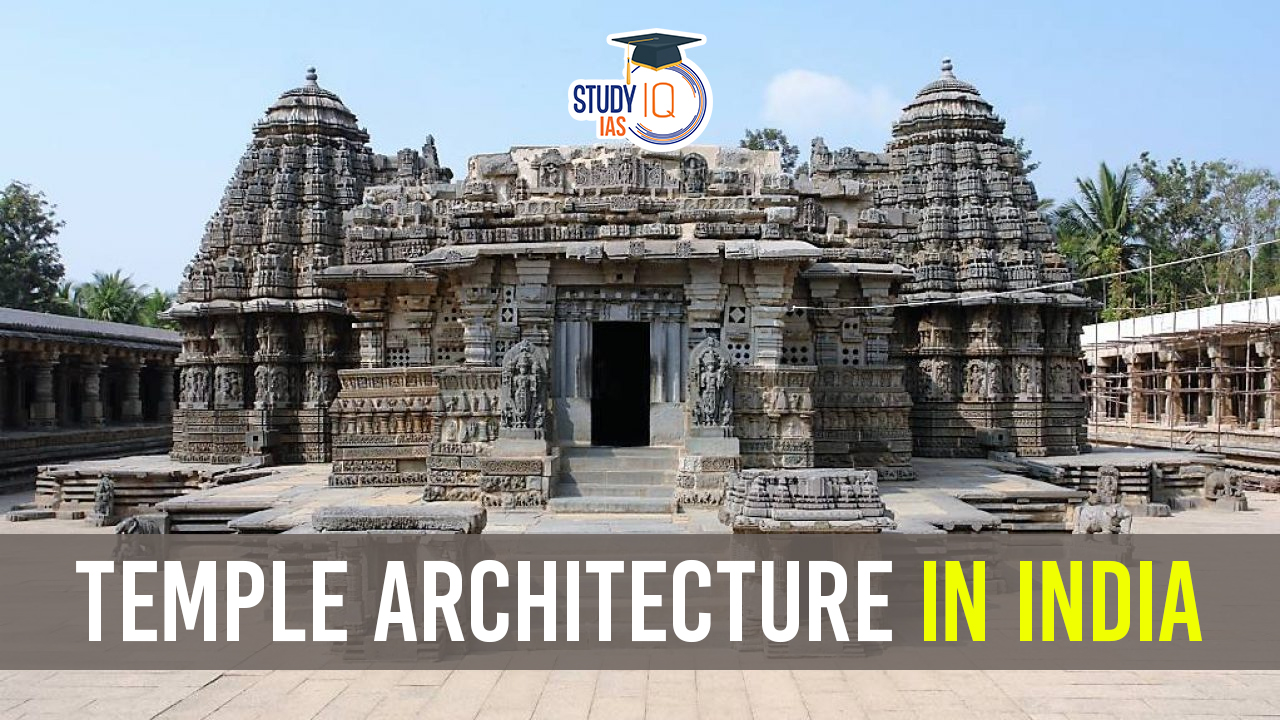Table of Contents
Temple Architecture in India spans diverse styles over millennia. In the Nagara style (200 BCE–800 CE), temples feature beehive-shaped towers. Dravida style (600–1500 CE) in the south is marked by pyramidal towers and intricate carvings. The Vesara style (700–1200 CE) blends northern and southern elements.
Hoysala architecture (11th–14th centuries) in Karnataka emphasizes intricate carvings. Maru-Gurjara style (8th–15th centuries) in the west showcases detailed carvings and domes. Vijayanagara temples (14th–17th centuries) boast grand scale and ornate pillars. Mughal influence (16th–19th centuries) introduced Islamic elements, while the colonial and modern periods saw a fusion of traditional and modern architectural forms. Indian temple architecture reflects the nation’s rich cultural and religious heritage.
We’re now on WhatsApp. Click to Join
Early Temple Architecture in India
The period of early temple architecture in India, spanning roughly from 500 BCE to 200 CE, is marked by the transition from Vedic rituals performed outdoors to the construction of dedicated temple structures. While the earliest temples were likely made of wood and have not survived, references to them can be found in ancient texts.
Key Features
Materials and Styles:
- Early temples used perishable materials like wood and thatch.
- Architectural styles varied by region, reflecting local traditions and available resources.
Structural Evolution:
- The shift to permanent structures led to the development of rock-cut and structural temples.
- Rock-cut temples showcased simplicity and functionality.
Bharhut and Sanchi Stupas:
- Notable for early monumental architecture.
- Focal points for Buddhist worship with intricate carvings of Jataka tales.
Yaksha and Yakshi Sculptures:
- Many temples featured sculptures of yakshas and yakshis.
- These sculptures, often outside temples, added to the aesthetic and religious ambiance.
Mauryan and Sunga Influence:
- Mauryan Emperor Ashoka influenced stupa construction.
- Sunga rulers expanded on architectural endeavours.
Development of Iconography:
- Emergence of standardized symbols and deity representations.
- Temples adorned with images of gods, laid the foundation for later elaborate iconography.
Religious Diversity:
- Temples catered to various traditions (Hinduism, Buddhism, Jainism).
- Diversity was evident in architectural elements and thematic sculptures.
Cave Temples:
- Construction of cave temples in natural rock formations.
- Example: Lomas Rishi Cave at Barabar Hills, Bihar, from the Mauryan period.
Nagara Style Temple Architecture in India
The Nagara style of temple architecture, prevalent in India from 200 BCE to 800 CE, is characterized by its distinct features that set it apart from other architectural styles. This style is most commonly associated with the northern and central regions of India. Here are the key characteristics and details of the Nagara style:
Key Features
Shikhara (Tower):
- The most prominent feature of the Nagara style is the beehive-shaped tower known as the shikhara.
- The shikhara rises in a curvilinear fashion, symbolizing the sacred mountain or cosmic mountain.
Mandapa (Porch):
- Nagara temples typically have a mandapa, or porch, which serves as an entrance hall.
- The mandapa is often supported by intricately carved pillars.
Garbhagriha (Sanctum Sanctorum):
- The innermost chamber of the temple is the garbhagriha, housing the principal deity.
- The garbhagriha is considered the most sacred part of the temple.
Vimana (Superstructure):
- The superstructure of the temple, including the shikhara, is collectively referred to as the vimana.
- The vimana symbolizes the abode of the deity and is intricately adorned with sculptures.
Amalaka and Kalasha:
- The topmost part of the shikhara is often adorned with a circular stone disk called the amalaka.
- A kalasha (pot-like structure) crowns the amalaka, representing cosmic energy.
Locational Variations:
- The Nagara style exhibits regional variations. For example, the temples in Odisha and Rajasthan may have distinct characteristics within the overarching Nagara framework.
Sculptural Ornamentation:
- Nagara temples are richly decorated with intricate sculptures and reliefs.
- The sculptures often depict various deities, mythical creatures, and scenes from Hindu epics.
Panchayatana Layout:
- Some Nagara temples follow the panchayatana layout, where subsidiary shrines are arranged around the main shrine.
- This layout symbolizes the cosmic order and the interconnectedness of various deities.
Nandi Mandapa:
- Many Nagara temples feature a separate structure dedicated to Nandi, the bull associated with Lord Shiva.
- This Nandi mandapa is usually positioned in front of the main shrine.
Evolution Over Time:
- The Nagara style evolved over the centuries, with later temples becoming more elaborate and larger in scale.
- Prominent examples include the temples at Khajuraho, Mount Abu, and Bhojpur.
The Nagara style, with its iconic shikhara and elaborate sculptural details, remains an integral part of India’s architectural heritage. Its influence can be seen in the temple structures across northern and central India, contributing to the diverse tapestry of Indian temple architecture.
Dravida Style Temple Architecture in India
The Dravida style of temple architecture, prominent in southern India, particularly in the states of Tamil Nadu, Karnataka, and Andhra Pradesh, is characterized by its unique features that distinguish it from other architectural styles. This style flourished from the 6th century CE onward and continues to influence the construction of temples in the region. Here are the key characteristics and details of the Dravida style:
Key Features
Vimana (Tower):
- The most distinctive feature of the Dravida style is the pyramidal tower or vimana that rises above the sanctum sanctorum (garbhagriha).
- The vimana is typically composed of several tiers, each marked by a horizontal molding.
Shikhara:
- Unlike the Nagara style, the Dravida shikhara is not curvilinear but rather pyramidal in shape, resembling a stepped pyramid.
- The top of the shikhara is adorned with a small structure known as the stupi or kalasha.
Mandapa (Porch):
- Dravida temples have a hall or mandapa, often with intricately carved pillars, leading to the main sanctum.
- The pillars are characterized by their vertical ridges and motifs.
Gopuram (Entrance Tower):
- Dravida temples are known for their monumental entrance towers or gopurams, which are ornately decorated with sculptures and reliefs.
- Gopurams are often elaborately carved with scenes from Hindu mythology.
Axial Alignment:
- Dravida temples are characterized by axial alignment, with the main entrance aligned with the sanctum sanctorum, providing a clear line of sight to the principal deity.
Prakara (Enclosure Walls):
- Temples in the Dravida style are enclosed by high walls known as prakara, creating a sacred space around the temple complex.
Pillared Corridors:
- Some Dravida temples feature pillared corridors around the main sanctum, providing devotees with a circumambulatory path (pradakshina).
Vyalas and Kirtimukhas:
- Sculptures of mythical creatures called vyalas and face with exaggerated features, known as kirtimukhas, are commonly found in Dravida temples.
Fivefold Floor Plan:
- Many Dravida temples follow a fivefold floor plan, known as panchayatana, where the main shrine is surrounded by four subsidiary shrines at the corners.
Examples of Dravida Temples:
- Brihadeshwara Temple, Thanjavur: A UNESCO World Heritage Site, it is a grand example of Chola Dravida architecture.
- Meenakshi Temple, Madurai: Known for its massive gopurams and intricate sculptures, it is a prime example of the Dravida style.
- Virupaksha Temple, Hampi: An ancient temple in Karnataka with a well-preserved Dravida-style vimana.
The Dravida style, with its emphasis on monumental entrance towers and pyramidal vimanas, continues to play a significant role in the architectural identity of southern Indian temples. It reflects the rich cultural and artistic traditions of the region, contributing to the diversity of Indian temple architecture.
Vesara Style Temple Architecture in India
The Vesara style of temple architecture, which emerged between the 7th and 12th centuries CE in India, is a unique blend of both Nagara and Dravida styles. Vesara represents a fusion of architectural elements from the northern (Nagara) and southern (Dravida) traditions, resulting in a distinct and harmonious style. Here are the key features and details of the Vesara style:
Key Features
Architectural Fusion:
- Vesara style represents a synthesis of Nagara and Dravida elements, showcasing a balanced combination of features from both traditions.
Shikhara (Tower):
- The shikhara in Vesara temples is usually pyramidal, similar to the Dravida style, but it may lack the stepped appearance seen in pure Dravida architecture.
Mandapa (Porch):
- Vesara temples often feature a mandapa with pillars, similar to the Nagara style, but the design may incorporate Dravida-style elements as well.
Entrance Gopuram:
- While Vesara temples may have an entrance gopuram (tower), it is generally smaller and less ornate compared to the elaborate gopurams seen in Dravida temples.
Axial Alignment:
- Like the Dravida style, Vesara temples typically follow axial alignment, ensuring a clear line of sight from the entrance to the sanctum.
Sculptural Ornamentation:
- Vesara temples often showcase intricate sculptures and carvings, drawing inspiration from both northern and southern traditions.
- The sculptures may depict deities, celestial beings, and mythological narratives.
Pillared Halls:
- The mandapas in Vesara temples frequently include pillared halls, reminiscent of the Nagara style, providing space for congregational activities and rituals.
Fivefold Floor Plan:
- Similar to both Nagara and Dravida styles, Vesara temples may adopt a fivefold floor plan, with the main shrine surrounded by four subsidiary shrines or corners.
Examples of Vesara Temples:
- Mallikarjuna Temple, Pattadakal: Located in Karnataka, this UNESCO World Heritage Site is a prime example of Vesara architecture, showcasing a harmonious blend of northern and southern features.
- Kashivishvanatha Temple, Pattadakal: Another temple in the Pattadakal complex exhibiting Vesara characteristics.
Regional Variations:
- Vesara architecture varies across regions, and regional influences may impact the specific elements incorporated into the temple design.
The Vesara style reflects a period of cultural and artistic exchange between the northern and southern regions of India. It symbolizes a synthesis of diverse traditions, resulting in a distinctive architectural style that is both aesthetically pleasing and culturally significant. Vesara temples contribute to the rich tapestry of Indian temple architecture, showcasing the adaptability and creativity of ancient builders and artisans.
Hoysala Temple Architecture
Hoysala architecture flourished in the Deccan region of India, particularly under the Hoysala dynasty from the 11th to the 14th centuries. Key features of this style include intricate stone carvings, especially on temple exteriors, and a unique star-shaped platform. Prominent examples include the Chennakesava Temple at Belur, the Hoysaleswara Temple at Halebid, and the Kesava Temple at Somanathapura. The temples are known for their detailed reliefs depicting mythological narratives, finely carved sculptures, and lathe-turned pillars.
Maru-Gurjara Temple Architecture in India
Maru-Gurjara architecture, prevalent in the western part of India, particularly in Gujarat and Rajasthan, from the 8th to the 15th centuries, showcases a blend of indigenous and foreign influences. Characterized by intricate carvings, domes, and stepped wells (step-wells or vavs), this style reflects the cultural diversity and artistic prowess of the region. Notable examples include the Dilwara Temples in Mount Abu and the Rani ki Vav in Patan, known for their architectural grandeur and exquisite craftsmanship.
Vijayanagara Temple Architecture in India
Vijayanagara architecture emerged during the rule of the Vijayanagara Empire in the Deccan from the 14th to the 17th centuries. This style is marked by colossal structures, ornate pillars, and extensive use of relief sculptures. The Virupaksha Temple in Hampi, the Vittala Temple complex, and the Hazara Rama Temple are exemplary of Vijayanagara architecture. The temples feature large courtyards, intricately carved pillars, and a profusion of sculptures depicting deities, mythological narratives, and daily life.
Mughal Influence on Temple Architecture in India
Mughal architecture, spanning the 16th to the 19th centuries, is characterized by grandeur, symmetry, and a synthesis of Persian, Indian, and Central Asian elements. Notable structures include the Taj Mahal, Fatehpur Sikri, and the Red Fort. Features such as bulbous domes, minarets, and intricate geometric patterns showcase the Mughal style. Gardens, water channels, and calligraphy contribute to the overall aesthetic. Mughal architecture significantly influenced Indian temple construction, as seen in the Akbari and Shah Jahan style temples, exemplified by the temples in Khajuraho.
Temple Architecture in India: Colonial and Modern Periods
During the colonial period, European influences blended with existing architectural styles. Churches and administrative buildings reflected colonial aesthetics. In the modern period, traditional styles persisted, but new materials and construction techniques emerged. Architectural diversity expanded with the incorporation of global influences. Contemporary structures, including temples, mosques, and public buildings, exhibit a fusion of traditional and modern elements, reflecting India’s dynamic cultural and architectural evolution. Examples include the Akshardham Temple in Delhi and the Lotus Temple, showcasing innovative designs and materials in the 20th and 21st centuries.
Temple Architecture in India UPSC
Indian temple architecture has evolved over millennia, showcasing diverse styles. Nagara temples (200 BCE–800 CE) in the north feature beehive-shaped towers. Dravida temples (600–1500 CE) in the south have pyramidal towers and intricate carvings. Vesara style (700–1200 CE) blends northern and southern elements. Hoysala architecture (11th–14th centuries) emphasizes intricate carvings. Maru-Gurjara style (8th–15th centuries) showcases detailed carvings and domes. Vijayanagara temples (14th–17th centuries) boast grand scale and ornate pillars. Mughal influence (16th–19th centuries) introduced Islamic elements. In the colonial and modern periods, a fusion of traditional and modern forms emerged. Indian temple architecture reflects the nation’s rich cultural and religious heritage.


 UNESCO World Heritage Sites of India Lis...
UNESCO World Heritage Sites of India Lis...
 Moran Community of Assam, History, Langu...
Moran Community of Assam, History, Langu...
 Ho Tribe: History, Culture, Language and...
Ho Tribe: History, Culture, Language and...




















